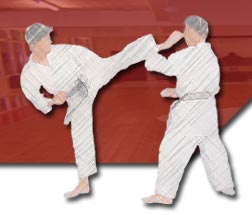|
MSKF
INFORMATION
HOME
NEWS
& EVENTS
VIDEO GALLERY
HISTORY
OF MSKF
ETIQUETTE
& RULES
INSTRUCTOR
PROFILES
CLUB
INFORMATION & TRAINING TIMES
CONTACT
US
KARATE
INFORMATION
TERMINOLOGY |
|

STANCES - DACHI
Fudo dachi - rooted stance. Now also referred to as Sochin dachi,
but they are two separate stances.
Gankaku dachi - crane stance, as used in the kata Gankaku.
Hachji dachi - open leg stance. The feet are positioned about one
shoulder length apart and pointed outwards at 45 degrees. It actually
translates to "figure of eight stance" and the true full
name for this stance should be "soto hachji dachi" and
when the feet are angled in at 45 degrees the name is "uchi
hachji dachi".
Hangetsu dachi - half moon stance.
Heiko dachi - parallel stance.
Kiba dachi - straddle stance. Also known as horse riding stance.
Kokutsu dachi - back stance.
Kosa dachi - cross stance or as it is more commonly called "crossed
feet stance".
Musubi dachi - informal attention stance, Heels placed together
but with each foot turned out at 45 degrees
Naihanchi dachi - kiba dachi, but with
the feet turned in. funakoshi changed the name from naihanchi to
tekki.
Naname shiko dachi - diagonal straddle leg stance.
Neko-ashi dachi - cat foot stance.
Renoji dachi - L stance
Sagi ashi dachi - heron leg stance.
Sanchin dachi - hour-glass stance.
Shiko dachi - square stance, or four thigh stance also sometimes
called "sumo stance"
shizen dachi - natural stance
Sochin dachi - diagonal straddle stance. Immoveable stance. Also
now referred as fudo dachi but they are twp different stances. In
fudo dachi the weight is further forward.
Tachi - standing or stance. To stand up would be tachigaru. In some
older works you may also see zenkutsu tachi etc. instead ofdachi.
Teiji dachi - a stance with the feet in a "T- shape"
Tsuru Ashi Dachi - crane leg stance.
Uchi-hachji dachi - inverted open leg stance, or iverted figure
of eight stance. The feet are shoulder width apart but the feet
are facing inwards.
Zenkutsu dachi - forward leaning stance. The actual translation
means front knee bent stance.
|

